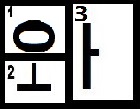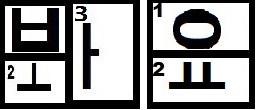Let's use another verb : 오다 = (oda) to come
오 + ㅏ = 와 (wa)

We will tackle three character blocks later. Just memorize this one.
For the pronunciation : o-a melts into wa
It is pretty logical. Try to say very quickly ' o-a o-a o-a' and you will automatically say 'wa wa wa.
와요 = (wayo) I come (= You come, he comes...)
바에 와요. ( pa-e wayo.) I come to the pub. ( = You come to the pub. / He comes to the pub...)
바다에 와요. ( pada-e wayo.) I come to the sea. (= You come to the sea. / He comes to the sea...)
보다 behaves the same way as oda . When we add yo it turns into 봐요 pwayo.

to see something requires that I transform this something into an object. e.g. 바다 (pada) the sea needs a suffix attached to it, if I want to see it.
There are 2 options: 을 (eul) and 를 (reul)
으 = eu (uh) is the last vowel lacking in our list. Like 'i' it can't take an extra line (y).
Also take note of the two different pronunciations of the letter ㄹ. At the beginning of the syllable it is r at the end it is l (reul).
- Words ending in a consonant take 을 (eul)
- Words ending in a vowel take 를 (reul)
Actually we only have learned words ending in vowels up till now and this for a very simple reason: The Number 2 in a syllable block is always a vowel. In order to end with a consonant we need bigger blocks.
So let's build our objects:
바 + 를 = 바를 (pareul) the bar
바다 + 를 = 바다를 (padareul) the sea
나비 + 를 = 나비를 (nabireul) the butterfly
비 + 를 = 비를 (pireul) the rain
Now we can build sentences:
- 바를 봐요. (Pa-reul pwayo.) I see the bar.
- 바다를 봐요. (Padareul pwayo.) I see the sea. (= Do you see the sea? - By raising our voice in the end we can make this even a question.)
- 나비를 봐요 (Nabireul pwayo) I see the butterfly.
- 비를 봐요. (Pireul pwayo.) I see the rain.
- 바나나를 봐요. (Pananareul pwayo.) I see the banana.
